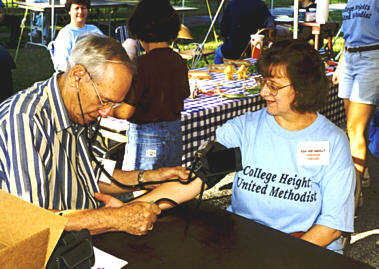| By Michael Wacht LAKELAND
— It had the ordinary bazaar components: face painting, popcorn machines, arts and
crafts, home-baked goods, and entertainment. Then, there was the not so ordinary: a church
intentionally creating a safe place where members could meet their unchurched neighbors
and
discover the needs of the community.
“We were not inviting them into our world, but creating a space where the two worlds
—churched and unchurched — could come together,” said the Rev. William
Oakley, pastor of College Heights United Methodist
Church in Lakeland. “People could be on church property without thinking they
were being roped into a service or some commitment.”
The church closed down its street Oct. 10 and opened its grounds to the community for a
first-ever Fellowship and Community Outreach Bazaar. The invitation was accepted by
“easily 1,000 [people] and probably a lot more than that,” Oakley said.
The purpose of the bazaar was not to make money, but to get to know the community and
allow the community to get to know the church, said the Rev. William A. Fisackerly III, a
retired pastor and co-chair of the planning committee.
Neighborhood associations, local government offices, law enforcement agencies, emergency
services and the Citrus Regional Bloodmobile were among the groups that participated.
Nearby churches were also asked to present information on their ministries, Fisackerly
said, adding that most churches were surprised by the request.
According to Oakley, more than 180 church members worked on the project. “The bazaar
was a success for the church before the event itself, bringing members of the church
together to cooperate,” he said. The church benefited from “working together and
enjoying each other’s contributions.”
Oakley says the idea for the event was stimulated by the Council
of Bishops’ Initiative on Children and Poverty and Operation Evangelization,
Florida Bishop Cornelius L. Henderson’s campaign to reach 400,000 members by the year
2000.
Those programs started conversations within the church about what it could do to reach out
to its community. “We thought, ‘Gee, how many kids are there in our neighborhood
and what are their needs?’ ” Oakley said.
Although the church has provided meeting space for community groups like Crime Watch, church members wanted to do more
to break down the barriers between themselves and their neighbors. Oakley said they wanted
the community to know that despite the church’s “foreboding” appearance,
“it’s where real people go and meet and worship.”
And now, he says, the barriers have begun to come down. People who went to the bazaar have
visited the church for worship and several families are attending regularly.
“We know how hard it is to communicate to the community that the church is
open,” he said. “So, we gave [the community] an experience with church that was
not churchy.”
Top of this page
© 1998 Florida United Methodist Review Online |
![]()
![]()
![]()
![]()
![]()
![]()
![]() Florida Southern College
Florida Southern College![]()
![]() Bethune Cookman College
Bethune Cookman College![]()
![]() FL
UM Children's Home
FL
UM Children's Home![]()

